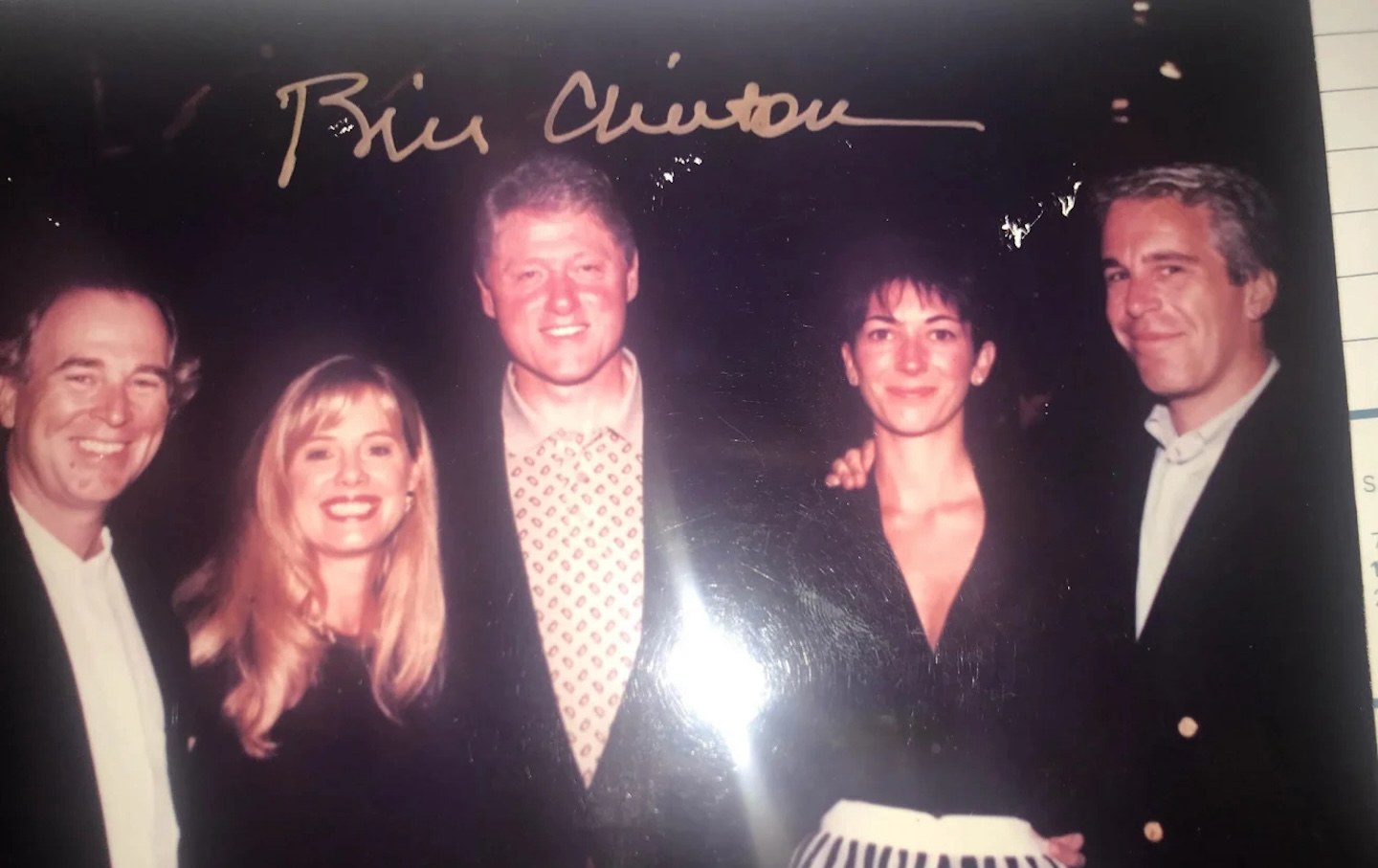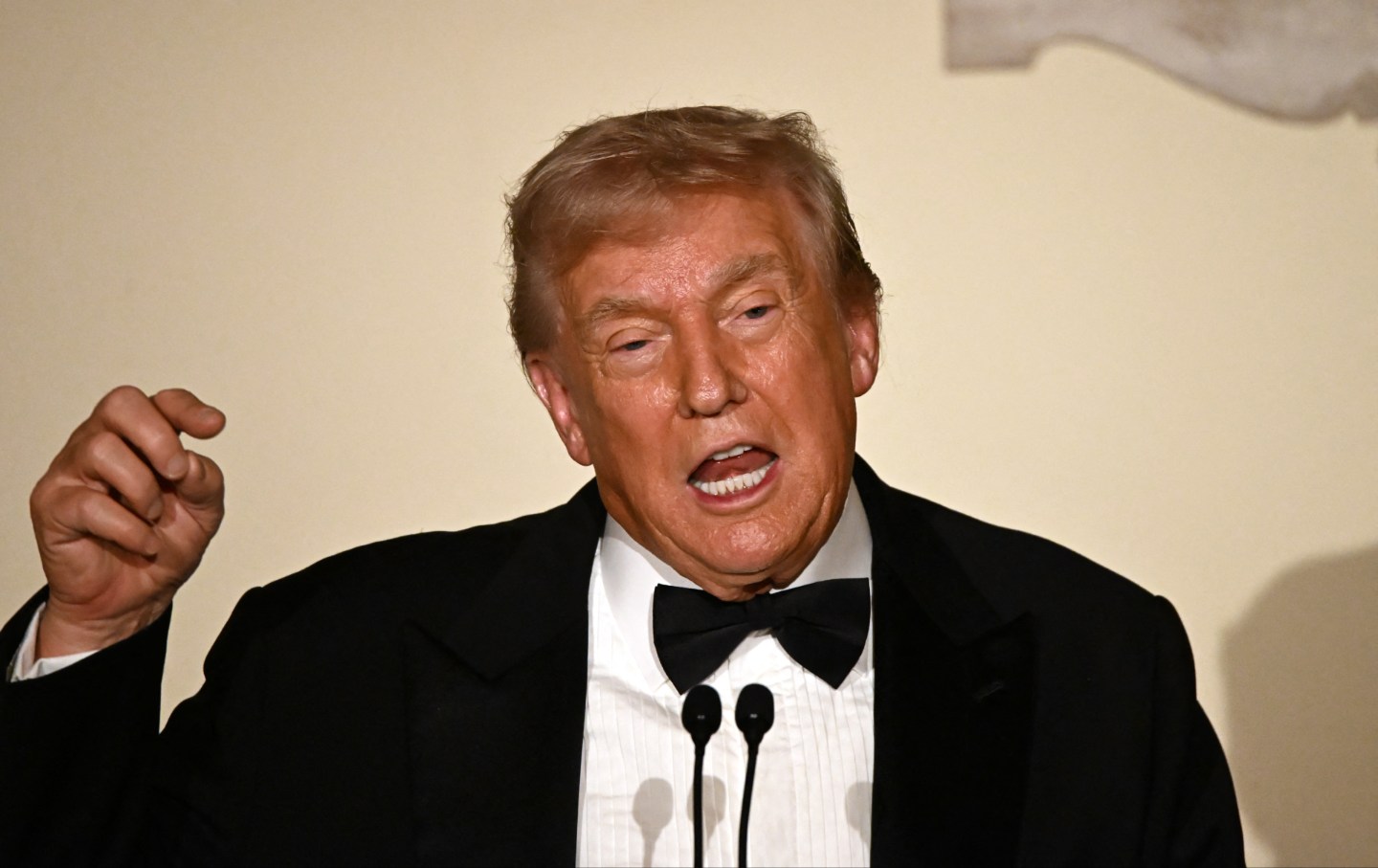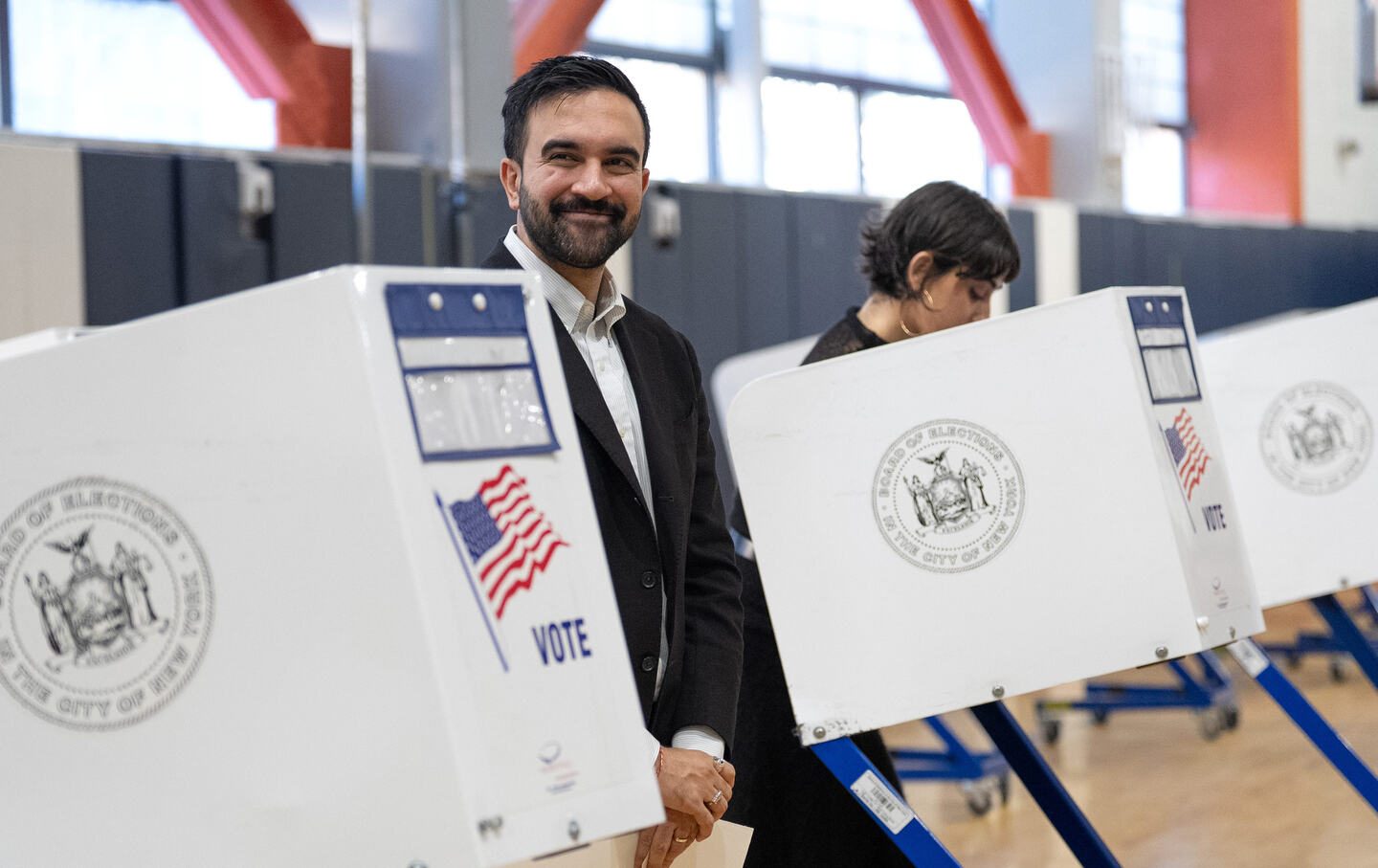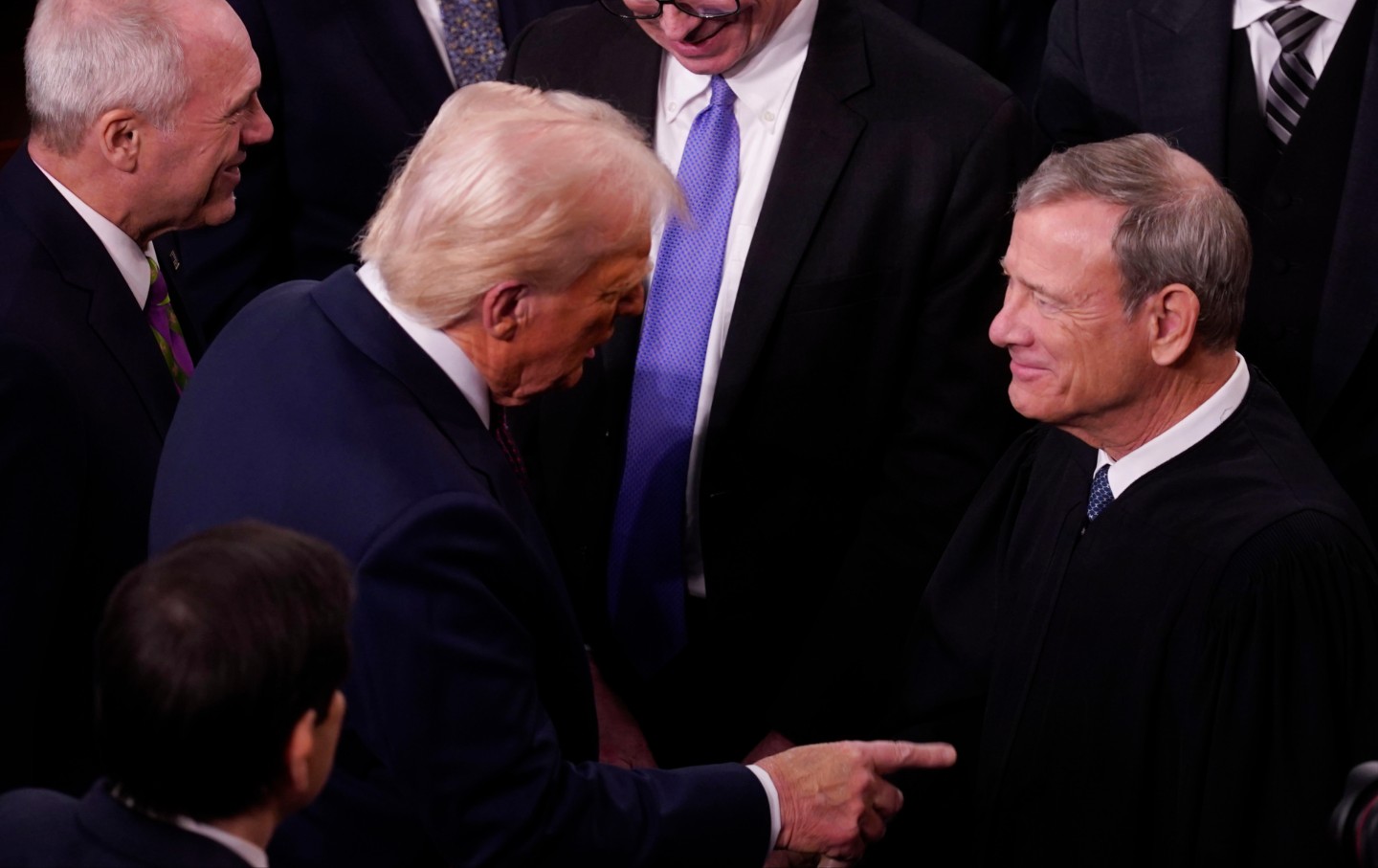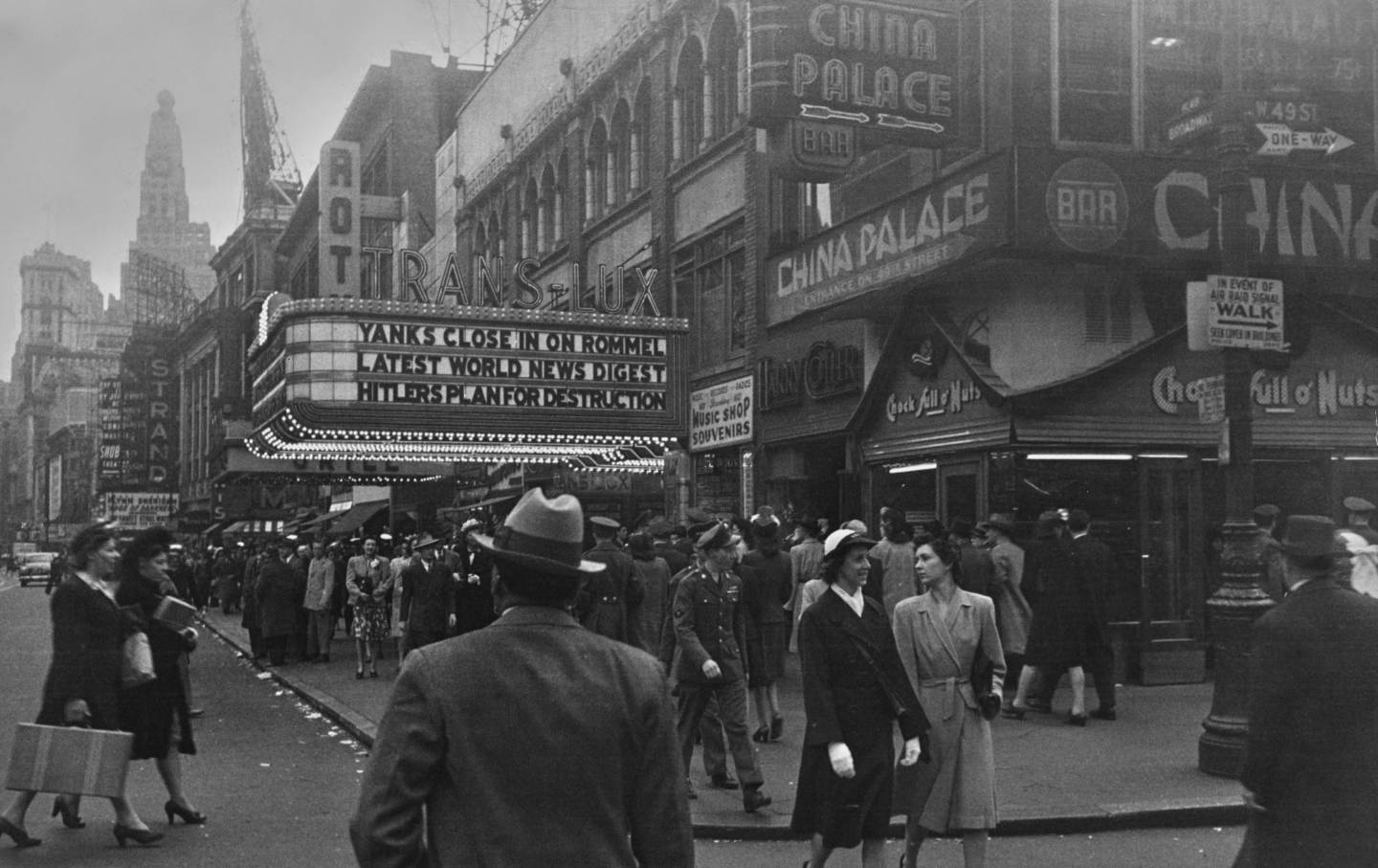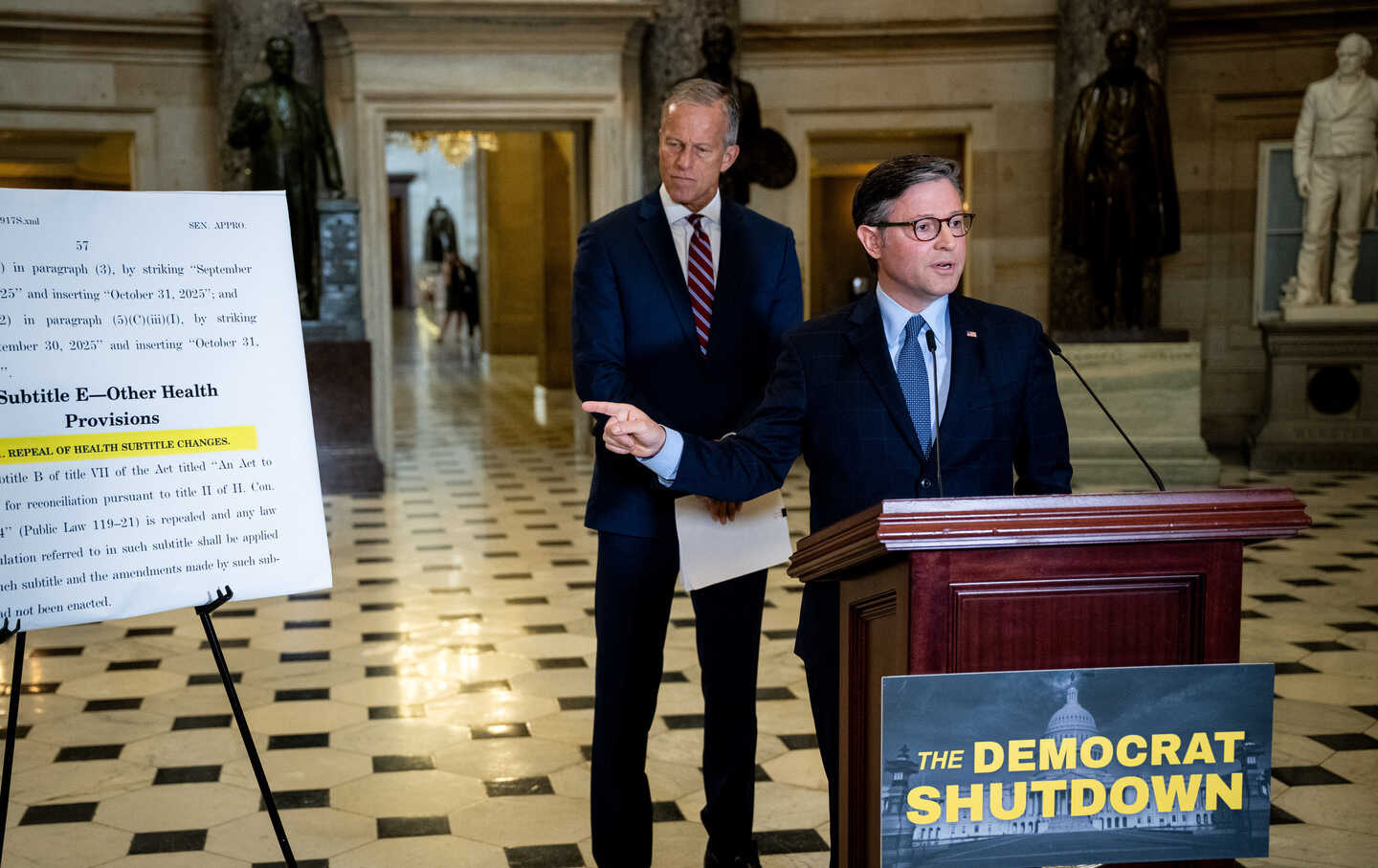How Dems Can Win Rural Voters, Plus Who’s Afraid of Gender?
How Dems Can Win Rural Voters, Plus “Who’s Afraid of Gender?”
On this episode of Start Making Sense, Anthony Flaccavento talks about a Rural New Deal, and Katha Pollitt critiques Judith Butler’s new book.
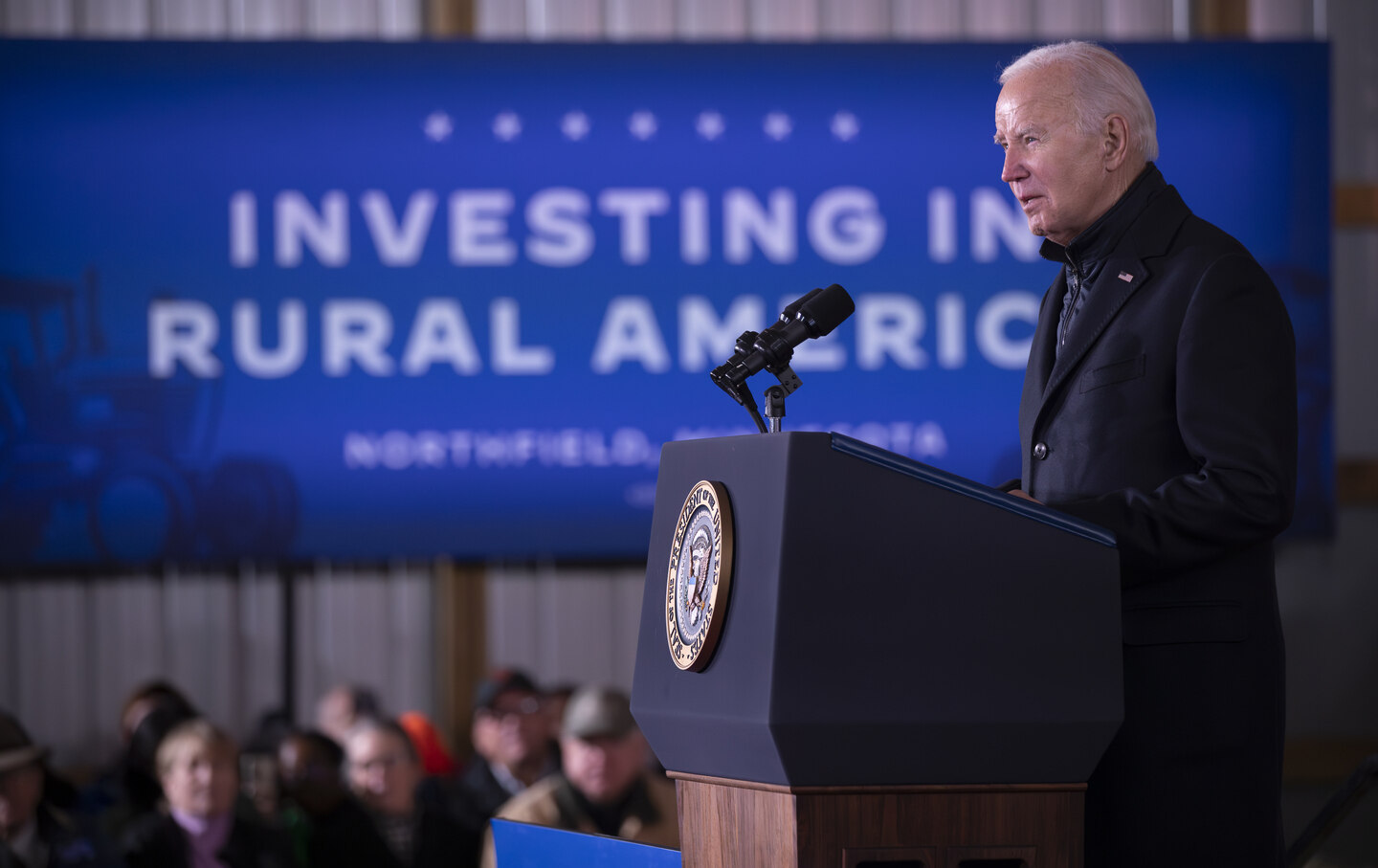
President Joe Biden speaking at the Dutch Creek Farms as he kicked off his Rural Investment Tour on November 1, 2023.
(Christopher Mark Juhn / Anadolu via Getty Images)Rural America is Trump country. In 2016, Hillary got barely 30 percent of the rural vote. Biden did only a little better in 2020. But he can do a lot better than that this year—and he needs to, if he’s going to carry some of the swing states. Anthony Flaccavento will explain—he’s a cofounder and the executive director of the Rural Urban Bridge Initiative.
Also: Judith Butler may be the most famous feminist theorist in the world today. Now, Butler has a new book out, with the provocative title, Who’s Afraid of Gender? Katha Pollitt provides a critique.
The views expressed in this podcast do not reflect the editorial views of The Nation.

Here's where to find podcasts from The Nation. Political talk without the boring parts, featuring the writers, activists and artists who shape the news, from a progressive perspective.
Ths coming Friday is the deadline for the Justice Department to turn over the Epstein files to Congress. But we already know the key fact about Epstein’s famous friends–they didn’t care that he had hired a 14-year-old girl for sex—and gone to jail for it. But why was that? Katha Pollitt comments.
Also: the hidden politics of the New York Times crossword puzzle: Natan Last explains; his new book is Across the Universe: the Past, Present, and Future of the Crossword Puzzle.
Our Sponsors:
* Check out Avocado Green Mattress: https://avocadogreenmattress.com
Advertising Inquiries: https://redcircle.com/brands
Privacy & Opt-Out: https://redcircle.com/privacy
Jon Wiener: From The Nation magazine, this is Start Making Sense. I’m Jon Wiener. Later in the show, Katha Pollitt will talk about Judith Butler, who may be the most famous feminist theorist in the world today. Now Butler has a new book out, with the provocative title, “Who’s Afraid of Gender?”
But first: Democrats and rural voters. In 2016, Hillary got barely 30 percent of the rural vote.
Biden did only a little better in 2020. But Biden can do significantly better this year. Anthony Flaccavento will explain – in a minute.
[BREAK]
Rural America is Trump country. A lot of Democratic campaigns have conceded rural voters to the Republicans and focused on campaigning in cities and suburbs. But if Democrats could get more rural votes, especially in swing states, they could reelect Joe Biden, reclaim the House, and retain the Senate. How to do that? For some answers, we turn to Anthony Flaccavento. He’s an organic farmer and rural development consultant and co-founder of the Rural Urban Bridge Initiative. He’s also author of the book, Building a Healthy Economy from the Bottom Up: Harnessing Real-World Experience for Transformative Change. And he’s a contributor to The Nation. We reached him today in Abingdon, in southwest Virginia. Anthony Flaccavento, welcome to the program.
Anthony Flaccavento: So happy to be here, Jon. Thanks for having me.
JW: The congressional district in southwest rural Virginia, where you live, had a Democratic congressman for 28 years until 2010. Now the district is more than 70% Republican. You ran for that congressional seat as a Democrat in 2012 and in 2018. How do you explain its transformation from purple to deep red? What happened? Why did people there vote for Trump?
AF: It seemed sudden at the time. Rick Boucher was that Democratic candidate for 28 years. He’s a friend of mine and he was the consummate politician who brought home the bacon. He had positions on all the major issues, but he was known by Democrats, Independents, and Republicans as somebody whose driving force was making the district better. So he was a constituent politician. That’s part of why he lasted as long as he did. But what happened was, in the 2010 Tea Party wave, he lost his seat. The same Republican incumbent has been in since, same guy I ran against.
And what seemed to be an abrupt shift was actually something that had been brewing in the ninth district of Virginia and across rural America for the better part of three decades at that point. And essentially it was this, the economy had shifted so dramatically and really worn down and hollowed out big chunks of rural America, small towns, small towns with manufacturing and all of that.
And that process was really aided and abetted by both Republicans and Democrats. That trickle-down globalization, investor driven trade junk was really a bipartisan consensus that led to that. Now, the Democrats always wanted to soften the blow a little more than the Republicans, but Bill Clinton signed NAFTA. Bill Clinton was with the Republicans in opening the WTO to China. Barack Obama essentially sat on the sidelines while corporate mergers went on and on. The definition of antitrust shifted to one that was so narrow and pathetic that corporations had to rule. And both Republicans and Democrats stood by either enabling it or actually actively pursuing it. So from the perspective of millions of working class and rural people, what they saw was two parties who really abandoned them, their jobs, their livelihoods. But while both parties abandoned them, the Republicans got damn good at talking to them and really recognizing the anger.
Now, in many ways, stoking it with half-truths and lies, but they recognize it. They said, “You people have been screwed. You’ve been left out. The liberal establishment doesn’t care about you. They make fun of you.” And that is all basically true. The Democratic response to this, like I say, was a little softer around the edges with more safety nets, but for the most part was to say, “Well, sorry folks. That’s what progress is about. So you better either get with the program and get a college degree and become either in the financial management industry or a coder, or you should move to the city.” So you had two parties that betrayed rural and working class people economically. But one party said, we feel for you. And the other party said, suck it up. So in a simplified way, that’s how we got to this point.
JW: Democrats used to do a lot better with rural voters. I learned from your piece in the nation that in 2008, Barack Obama won 45% of rural voters nationwide. In 2016, Hillary got barely 30%. So the big change comes with Trump. But how much of the blame goes to Hillary herself and her campaign?
AF: Well, I’d say a goodly bit, but again, Hillary Clinton was not an anomaly. She was just a culmination of really what had happened. And Obama’s 45% was a blip because the Democratic Party had been losing ground for a generation at that point. But what Obama did in his first campaign was he went to Iowa, he came to Abingdon where I am. He came to Appalachia, and he seemed to genuinely say to coal miners, to farmers, to people in manufacturing, “We care about you. The system hasn’t worked for you. We’re going to change that.”
But one of the things he did that really won him Iowa, was he held meetings with farmers around some obscure but critical law called the Packers and Stockyards Act, which is this law that governs the relationship between Tyson and the Big Ag conglomerates and the farmers they contract with. And he said, “This law isn’t fair to you. It gives all the power to the corporations and all the liability to you. We’re going to change that.” But when he got into office, he and Tom Vilsack just got beaten back by the corporate Ag lobby, and they let it go. So Obama surged because he showed that kind of empathy that people in rural areas were longing for. But when he got into office, he didn’t follow through.
JW: Your Rural Urban Bridge Initiative, did a big study of candidates running in rural America who over-performed, in quotation marks, that is. They got more votes than the average, more votes than expected. So we want to learn from them and from your findings about what does it take to win more votes? Maybe not a majority, but more will help Biden a lot, especially in those swing states where the margins are 20,000, 40,000 votes.
AF: That study came out in the fall of 2022, and it was based on interviews with 50 Democrats who ran in rural districts in 25 different states. And as you say, over-performed. Actually, a fair number of them won, but majority will just beat the partisan lean. Here’s the essential takeaways from that. It’s more than this, but this is it. Number one, the successful candidates were laser focused on local issues. They had positions on everything from trade policy to abortion, but over and over they stayed focused on the issues of their district, and people felt heard.
Secondly, they were themselves overwhelmingly local people. We refer to that as local fluency. They were either second, third, fourth, fifth generation, or even if they were a transplant, they were deeply rooted in the community, as schoolteachers, as part of the rescue squad. So they were very much a locally based candidate. The third thing was they absolutely were willing to be critical of both parties. They were not like, “Dems are great. Republicans suck.” They recognized both parties had problems with rural areas. And maybe a fourth big takeaway from that was that they stayed away from high paid consultants. They use local talent to run their campaigns, to do their media and social media. Some of them raised a good bit of money and were up on TV, but some of the really successful ones did not raise much money and used more of the personal contact.
JW: I want to talk specifically about the personal contact in the door knocking. One of the big issues that you took up was when the campaign workers knock on a door, do they start by saying what the candidate’s key issues are?
AF: No. Exactly right. So we weren’t the only ones to find this. Our study reinforced what other groups who’ve been doing, what some folks call deep canvassing, have been advocating for quite some time now. Which is to say, that the first step after the ‘hello,’ the first words out of your mouth are, ‘what are the issues on your mind?’ or ‘what do you care about?’ So it’s really a listening posture.
That tends to be dismissed by the politically savvy, so-called, because they just don’t think there’s time for it. Candidates and campaigns are all about how many doors did you knock on, how many calls did you make? But if you knocked on a thousand doors, but you were unsuccessful at 990 of them, what difference did it make? If you knocked on 200 doors, but you had a hundred relatively meaningful conversations, you’re in much better shape. So that was the key. Listen first. The second thing was that when they spoke, they spoke in a way that wasn’t contradictory. So if the person at the door said some things that they didn’t agree with, they didn’t argue, they didn’t scold, but instead they acknowledged that the person had those views and then provided their own views in a way that wasn’t morally superior.
JW: Another key issue here is who should do the door knocking? Do you want to bring in college students from nearby schools who want to become political activists?
AF: In general, no. But I don’t want to discourage, because I had college students working on my campaign. Here’s the key, if you could, if it’s a small enough district like Chloe Maxman had in Maine, then the candidate himself or herself is knocking on all the doors. That’s only possible from a super committed candidate in a small district. The number two was the candidate knocks on as many doors as possible, and the candidate surrogates are also locally grounded people who know local issues and who have been schooled in this, ‘listen first’. Then the third level is if you need to bring in volunteers, young, aspiring activist, college, great. But you must put them through a process so they understand and they come to people at the door in the same way the candidate would. Because then they can be helpful to you. If they come like most campaigns train activists to come, they will hurt you more than help you.
JW: And how about arguing that Trump is a threat to democracy and that that’s the most important issue facing America today?
AF: Well, there’s folks, some fairly prominent advisors and consultants, who are arguing that that’s the issue. We don’t know. What we believe is that saying that Trump is a threat to democracy or focusing on fascism or anything in that vein might bit by bit help rally some otherwise lukewarm liberals and Democrats. There are people who are pretty lukewarm about Biden, for instance, for good and for bad, and maybe that will get a few of them over the top to vote. But outside of that, if your goal is to reach working class and rural people, our research, not our original, but our understanding of the research is that that is not a motivator for most working class and rural people. And the reason isn’t because they embrace fascism, it’s because a lot of people feel the system has failed them so badly that when somebody says, “Look, our democracy is under threat”, their reaction is, “Well, the so-called democracy hasn’t worked for me and mine in a long time. I don’t think that’s that big a deal.” So that message doesn’t seem to work with people who already feel abandoned by the system.
JW: Joe Biden has gotten at least some of this message. He’s trying to campaign at least some in rural America. And so now it’s time for your Minnesota moment. That’s news from my hometown of St. Paul that you won’t get from Sean Hannity. Joe Biden visited Northfield, Minnesota, south of St. Paul in November 2023. This was the beginning of a national tour of rural communities. He went to a Minnesota hog farm where he lamented the loss of family farms. He attacked the corporate consolidation of agriculture. He pledged to oversee a renaissance of the American Heartland with $5 billion of funding for agriculture, for rural broadband, for clean energy. And in March 2024, Biden announced a $50 million initiative to support opioid treatment and recovery services in rural communities. So what do you think about these as issues to bring to rural voters?
AF: Well, I’ll tell you what, I was a Bernie guy through and through from 2016 on. And I was disappointed when Biden won the nomination. But that said, he has had, for working class and rural people, by far the most positive and transformative three plus years that we’ve had in my lifetime. It’s not even close, the comparison to Clinton and Obama, for instance, and certainly not the Republicans. So when Biden is going out to rural, when Biden is talking at a hog farm in Minnesota or an old factory town in the Rust Belt, he actually has major accomplishments to tout, not just promises.
He’s done, in terms of antitrust, a phenomenally aggressive anti-corporate platform. In terms of unions, major changes at the NLRB that are enabling and supporting workers to organize. In terms of small business and family farms, huge investments and some changes, although not enough, in Ag policy. So for the first time in forever, a Democratic candidate running for president out in the countryside actually has real substantial things to run on. He just needs to keep that message going, and then we need to see those investments come to life and come to fruition.
JW: And I know next door to Minnesota in Wisconsin, the Democratic Party chair, Ben Wikler is very proud about the fact that the party now has party organizations in every county, with locals running local campaigns year-round, not just to get out the vote the last couple of weeks before election day. That’s also the kind of thing that you think is essential.
AF: Absolutely. What’s happening in Wisconsin, the same process appears to be underway in North Carolina under the leadership of Anderson Clayton. And maybe to a lesser degree, but it looks very promising in both Michigan and in Minnesota with Ken Martin. I’m going to be, as I mentioned to you in Duluth, in about four or five weeks at their state convention. And this whole idea, it’s the Howard Dean 50 state strategy translated to a state level. It’s the every county strategy. It is still very much the exception. That is not the standard Democratic Party approach, but it’s taking root. And when you look at the results in Wisconsin, in Minnesota, in Michigan, you’re starting to see that actually this works. If your goal is to elect more Democrats and more progressive politicians, this works. So we are encouraged by that. RUBI-
JW: RUBI, R-U-B-I, Rural Urban Bridge Initiative.
AF: Sorry. Thank you, Jon. I just assumed that every person on the planet knew what RUBI was. The Rural Urban Bridge Initiative, our experience in research says that if your decision is a triage, that we can only go to the competitive places, and those are in cities and suburbs, then what you start is a self-fulfilling prophecy where you get like what we got in the ninth district. You go from being competitive to utterly uncompetitive in a matter of just a decade or so. To reverse that means just the opposite. You once again, start investing your policies, your presence, your investment in local parties and local candidates, even in very red districts. That is a must.
JW: And let’s emphasize here, Democrats will not be able to win most rural counties this November. Biden won 32% of the rural vote in 2020, but he can do better. And if he gets a few more votes there, 10,000, 20,000 votes, that can be the margin of victory. It has been the margin of victory in the past in Arizona, in Wisconsin, in Georgia, and it probably will be this November. Any final thoughts, Anthony?
AF: I think you’re spot on there. That margin of victory was probably John Fetterman’s reason for success. The fact that Biden got 2% more of rural than Hillary Clinton may well have accounted for his victory. And in the battleground states, there is a higher proportion of working class and rural voters, a key subset of whom are persuadable. Biden can do better, congressional candidates can do better, and it’s possible that not only would he win, but he’d retake Congress.
JW: Anthony Flaccavento: his article in the new issue of The Nation Magazine is titled, “The Only Thing Worse Than Taking Rural Voters for Granted is Dismissing Them… as out of reach for Democrats.” You can read it online at thenation.com. And you can find out more about the Rural Urban Bridge Initiative, RUBI, at ruralurbanbridge.org. Anthony, thanks for talking with us today.AF: Thanks so much for having me, Jon.
Subscribe to The Nation to Support all of our podcasts
Disobey authoritarians, support The Nation
Over the past year you’ve read Nation writers like Elie Mystal, Kaveh Akbar, John Nichols, Joan Walsh, Bryce Covert, Dave Zirin, Jeet Heer, Michael T. Klare, Katha Pollitt, Amy Littlefield, Gregg Gonsalves, and Sasha Abramsky take on the Trump family’s corruption, set the record straight about Robert F. Kennedy Jr.’s catastrophic Make America Healthy Again movement, survey the fallout and human cost of the DOGE wrecking ball, anticipate the Supreme Court’s dangerous antidemocratic rulings, and amplify successful tactics of resistance on the streets and in Congress.
We publish these stories because when members of our communities are being abducted, household debt is climbing, and AI data centers are causing water and electricity shortages, we have a duty as journalists to do all we can to inform the public.
In 2026, our aim is to do more than ever before—but we need your support to make that happen.
Through December 31, a generous donor will match all donations up to $75,000. That means that your contribution will be doubled, dollar for dollar. If we hit the full match, we’ll be starting 2026 with $150,000 to invest in the stories that impact real people’s lives—the kinds of stories that billionaire-owned, corporate-backed outlets aren’t covering.
With your support, our team will publish major stories that the president and his allies won’t want you to read. We’ll cover the emerging military-tech industrial complex and matters of war, peace, and surveillance, as well as the affordability crisis, hunger, housing, healthcare, the environment, attacks on reproductive rights, and much more. At the same time, we’ll imagine alternatives to Trumpian rule and uplift efforts to create a better world, here and now.
While your gift has twice the impact, I’m asking you to support The Nation with a donation today. You’ll empower the journalists, editors, and fact-checkers best equipped to hold this authoritarian administration to account.
I hope you won’t miss this moment—donate to The Nation today.
Onward,
Katrina vanden Heuvel
Editor and publisher, The Nation

